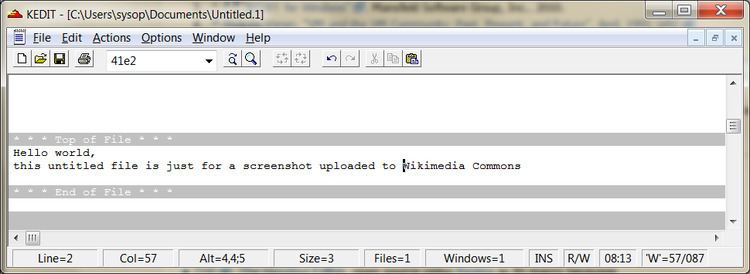 | ||
XEDIT is a visual editor for VM/CMS using block mode IBM 3270 terminals. (Line-mode terminals are also supported.) XEDIT is much more line-oriented than modern PC and Unix editors. For example, XEDIT supports automatic line numbers, and many of the commands operate on blocks of lines. One of the features is a command line which allows the user to type arbitrary editor commands. Because IBM 3270 terminals do not transmit data to the computer until certain special keys are pressed [such as ↵ Enter, a program function key (PFK), or a program access key (PAK)], XEDIT is less interactive than many PC and Unix editors. For example, continuous spell-checking as the user types is problematic.
Contents
Typical screen layout
MOHICANS SCRIPT A1 V 132 Trunc=132 Size=10 Line=10 Col=1 Alt=10XEDIT:===== Last of the Mohicans===== .sp===== It was a feature peculiar to the colonial wars of North America,===== that the toils and dangers of the wilderness were to be encountered===== before the adverse hosts could meet.===== A wide and apparently an impervious boundary of forests severed===== the possessions of the hostile provinces of France and England.===== The hardy colonist, and the trained European who fought at his===== side, frequently expended months in struggling against the rapids===== of the streams, or in effecting the rugged passes of the mountains|...+....1....+....2....+....3....+....4....+....5....+....6....+....7...===== * * * End of File * * *====> X E D I T 1 FileNotable features of the screen layout:
Macro language
XEDIT macros (scripts) can be written in REXX, EXEC2, or EXEC.
KEDIT 5 for DOS and OS/2 supports an external REXX interpreter (native OS/2 REXX or Quercus REXX, for DOS only Quercus REXX replacing the older Mansfield REXX) and its own rather limited KEXX subset. KEDITW 1.6.1 for Windows supports only its own internal KEXX 5.62 version of the REXX language. Macros can be arranged in the .kml file format.
XEDIT exposes the majority of its internal state to REXX, allowing macros to easily read and set internal variables that control its operation.
History
XEDIT was written by IBM employee Xavier de Lamberterie and was first released in 1980. Its predecessor was EDIT SP (SP is an initialism for System Product used by IBM). Other key influences were EDIT, the older editor for CMS, and EDGAR, an IBM Program Product editor for CMS. XEDIT supported many of the EDGAR commands, SOS (Screen Output Simulation) being a major one. XEDIT also supported EXEC2, the predecessor of REXX.
In December 2012 Mansfield Software released 1.6.1 to provide compatibility with Windows 8 and extended support to at least June 2015. These 32bit versions work also in the 64bit versions of Windows 7 and Vista, but do not directly support Unicode.
PC and Unix adaptations
When PCs and Unix computers began to supplant IBM 3270 terminals, some users wanted text editors that resembled the XEDIT they were accustomed to. To fill this need, several developers provided similar programs:
KEDIT 1.6 supports syntax highlighting for various languages including C♯, COBOL, FORTRAN, HTML, Java, Pascal, and xBase defined in the
.kld file format.